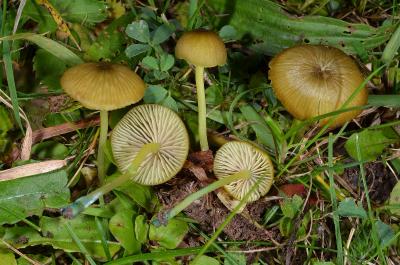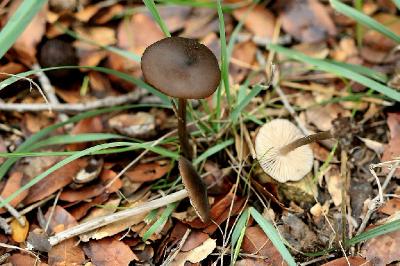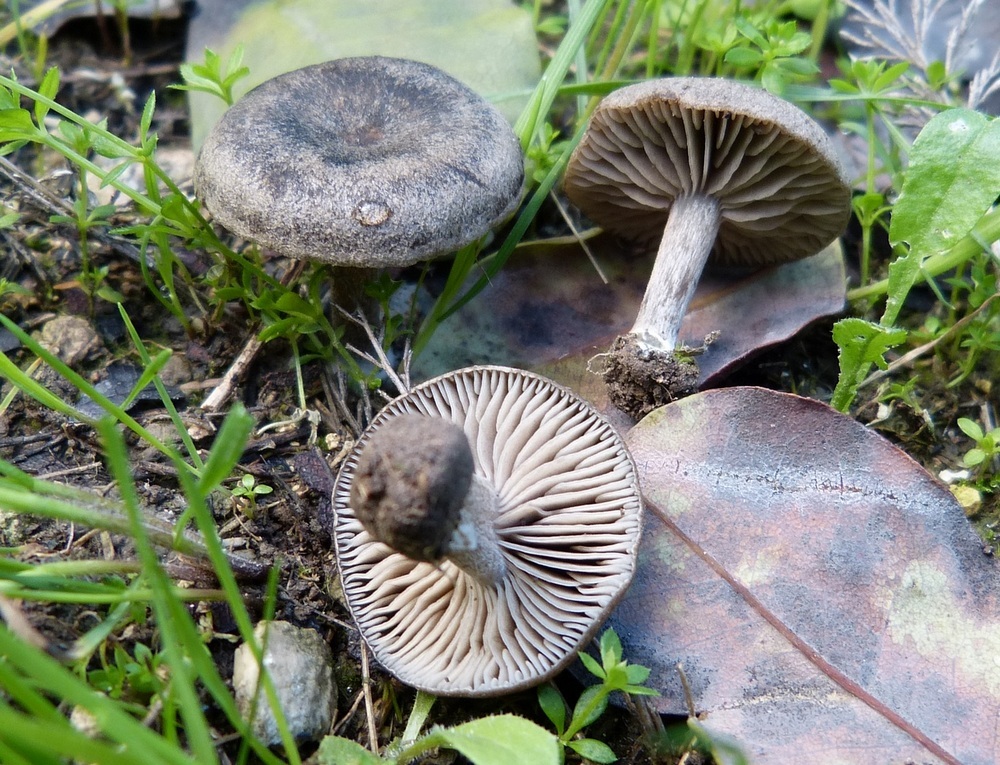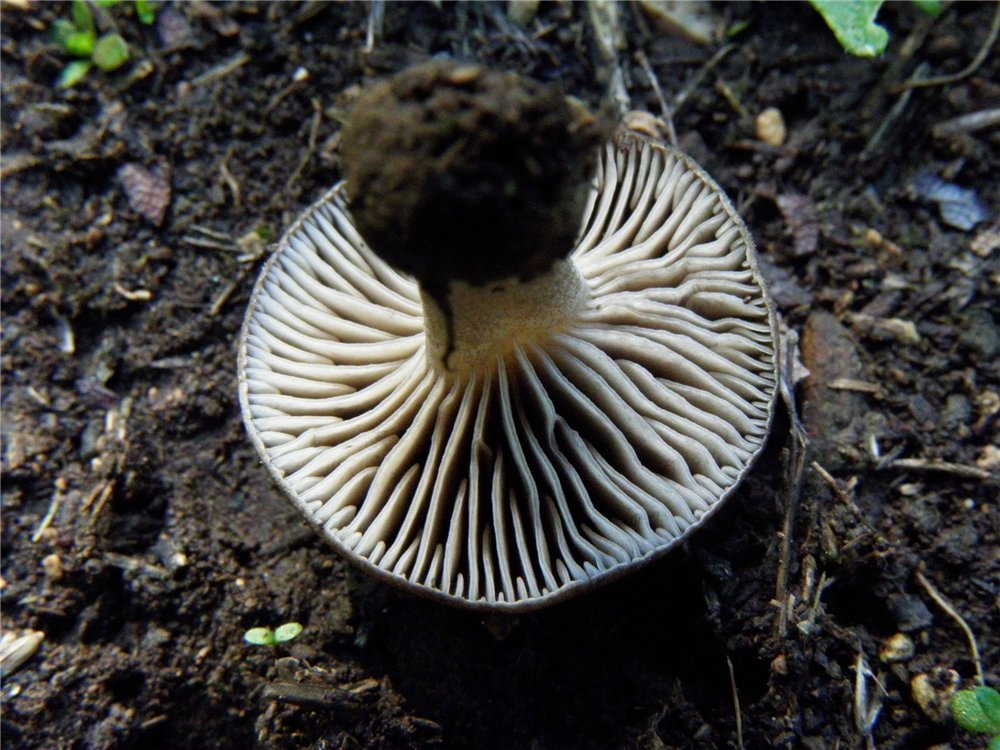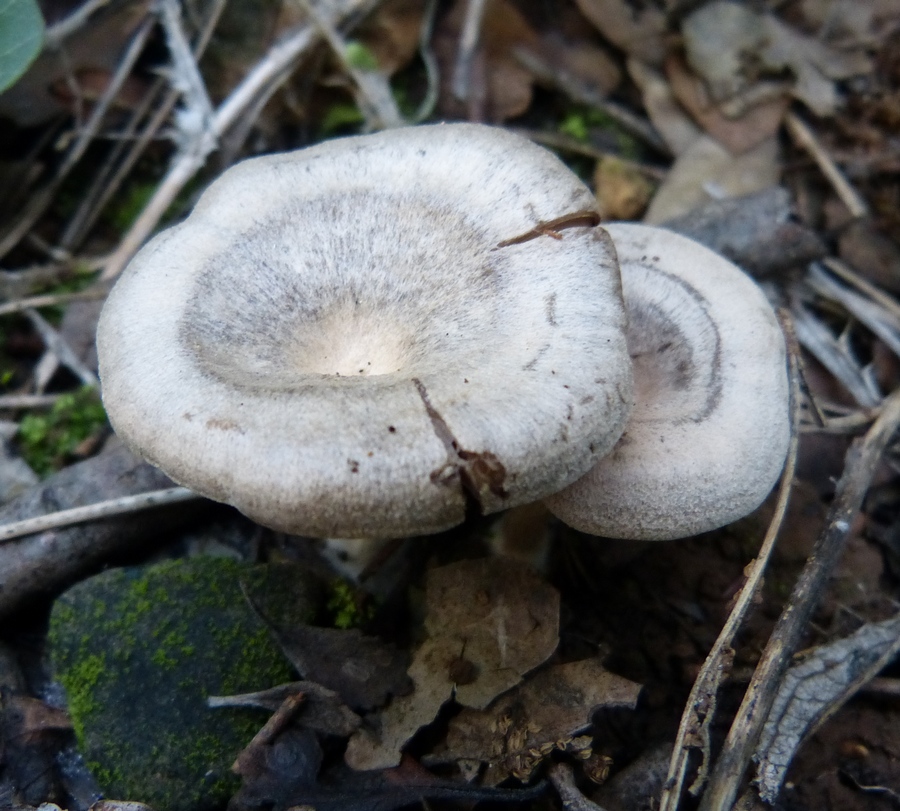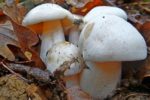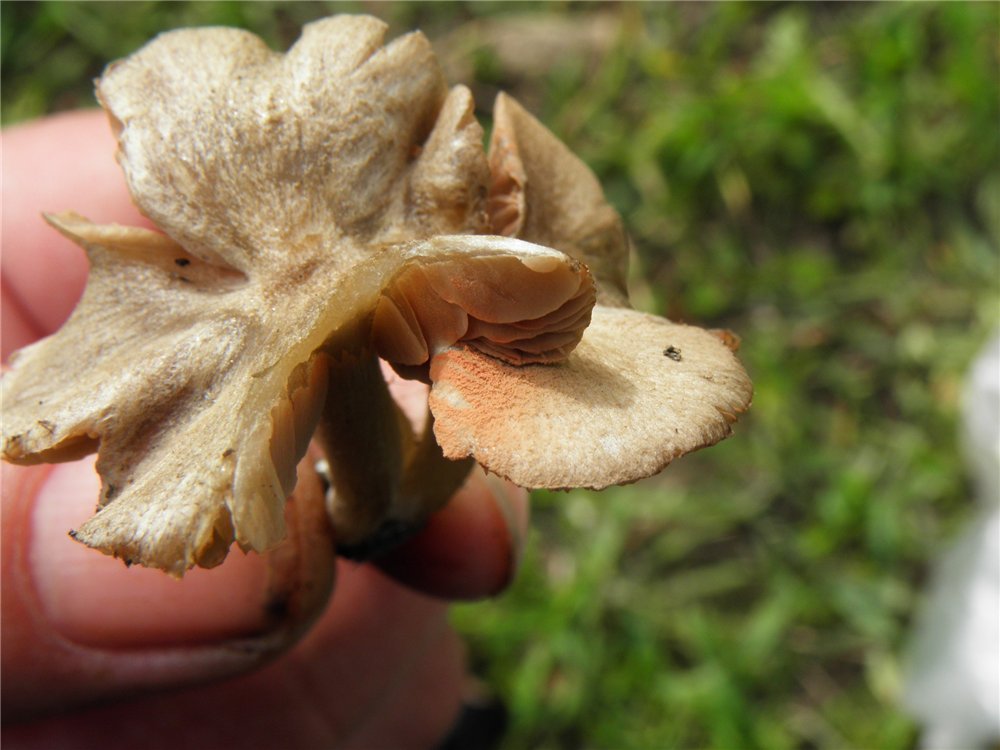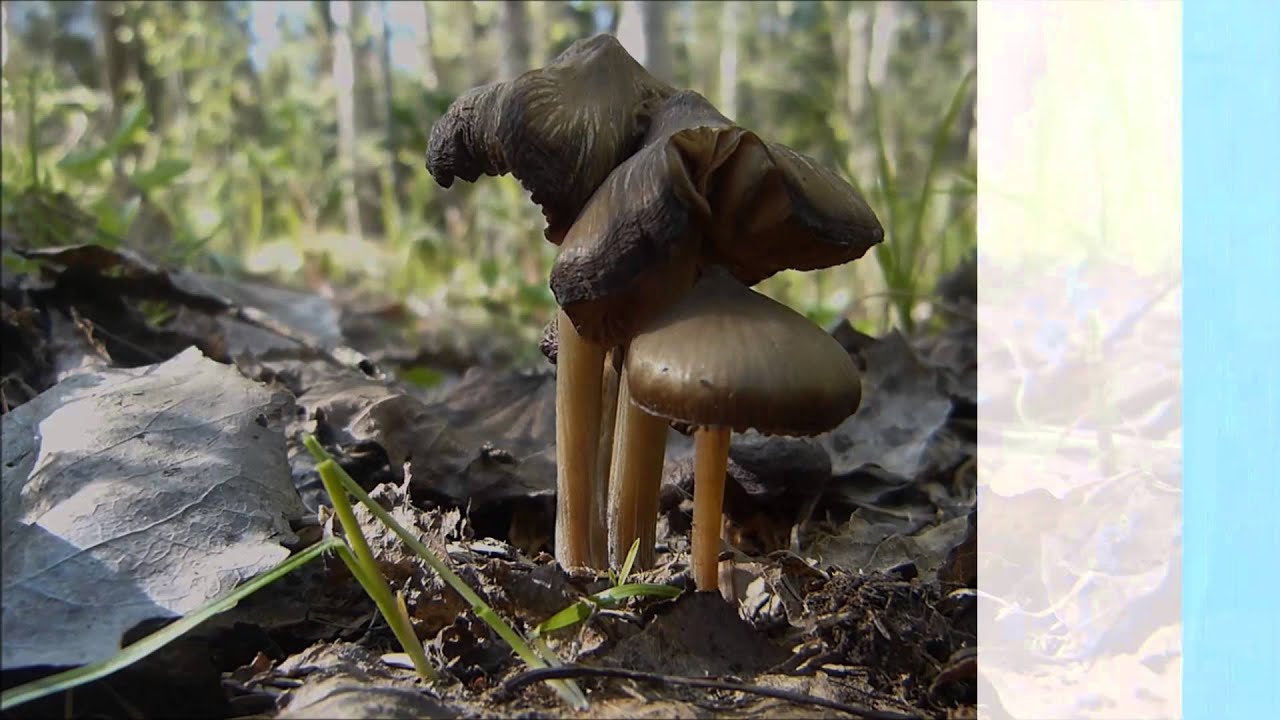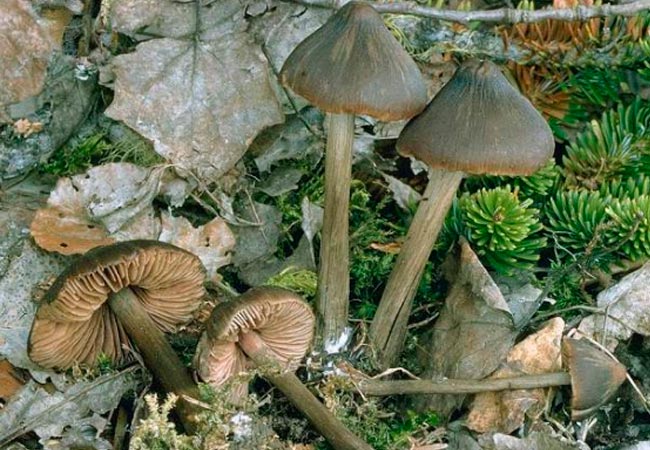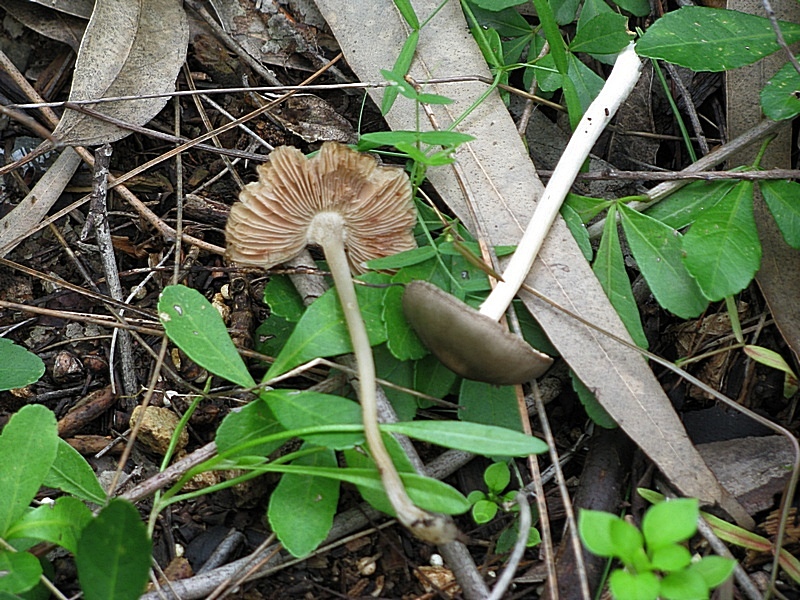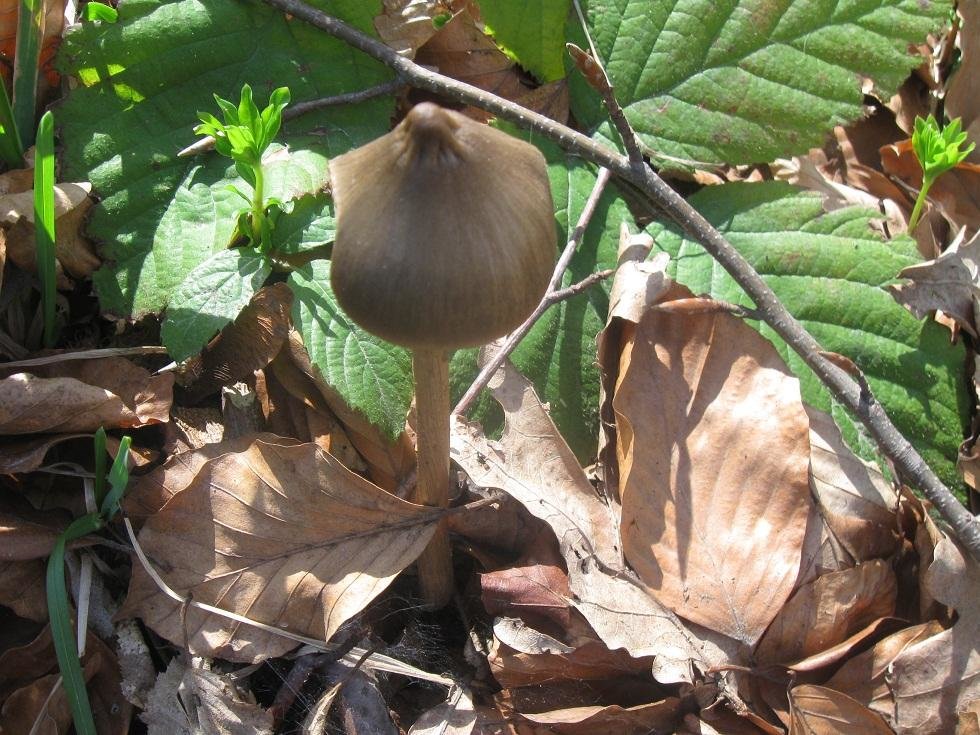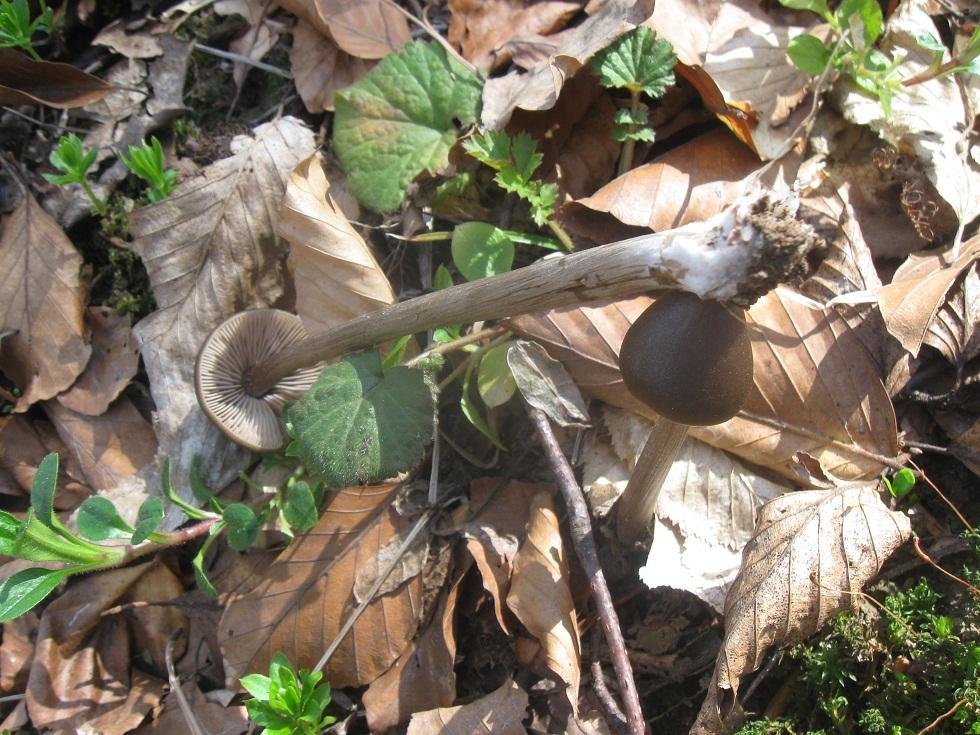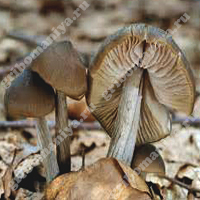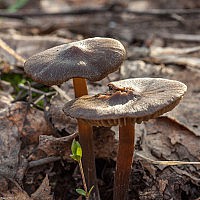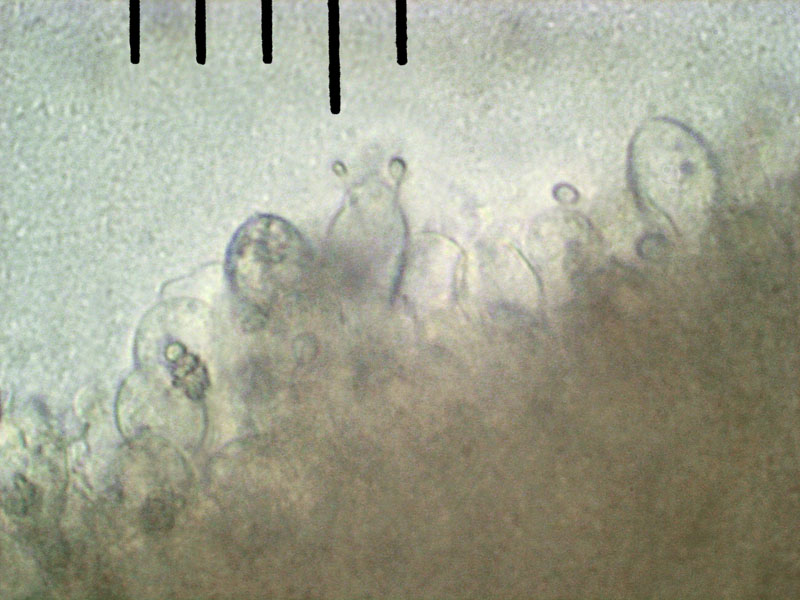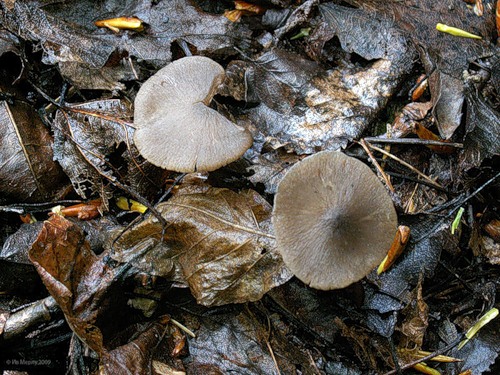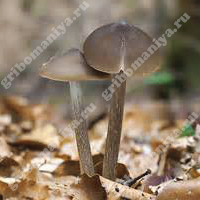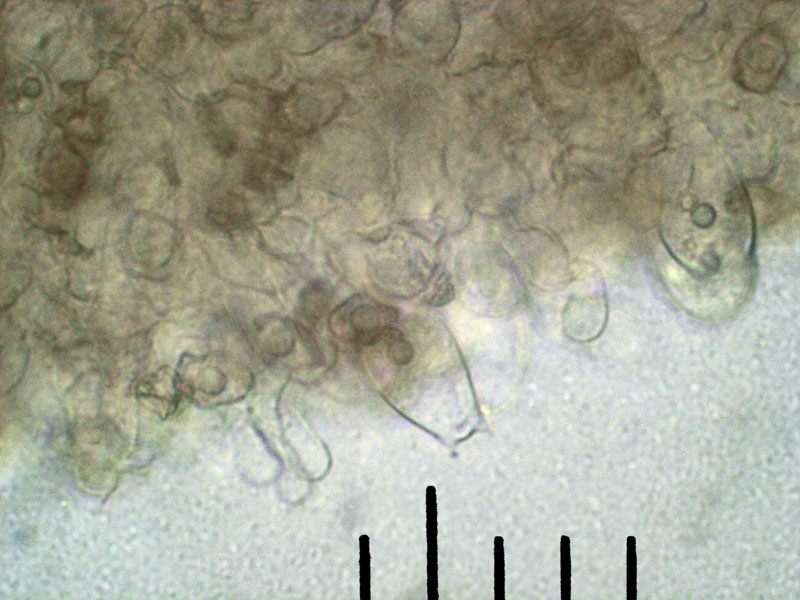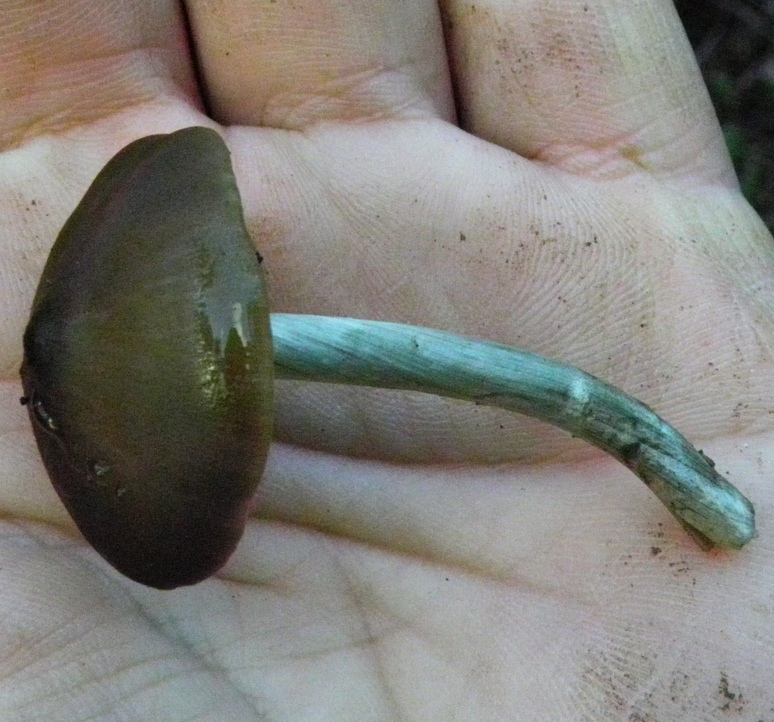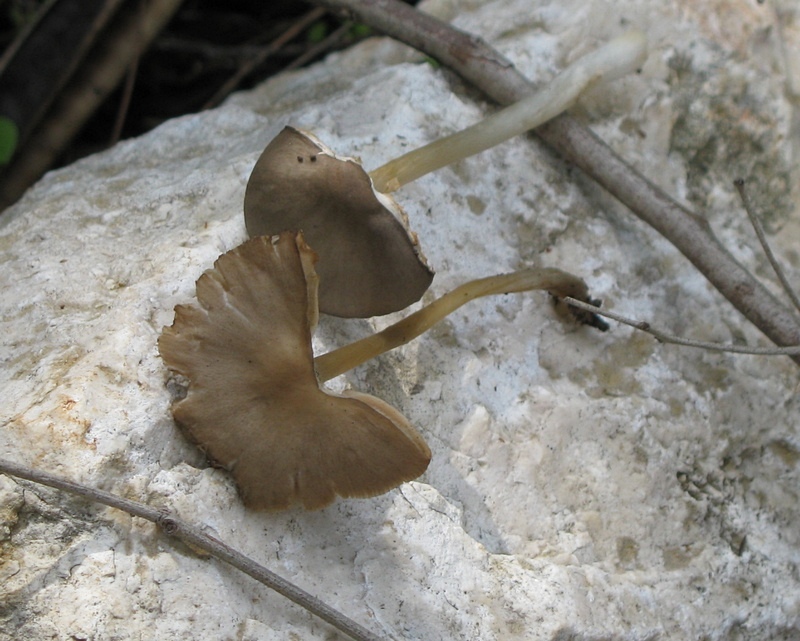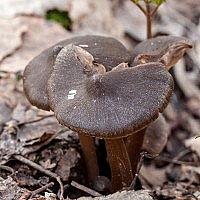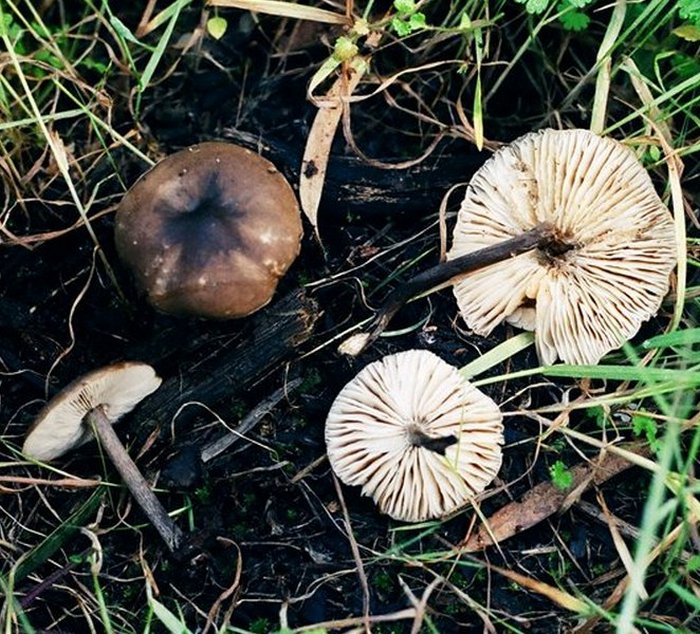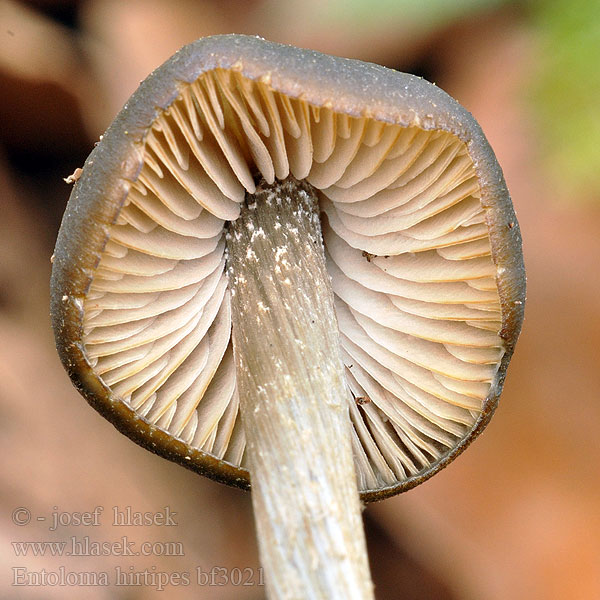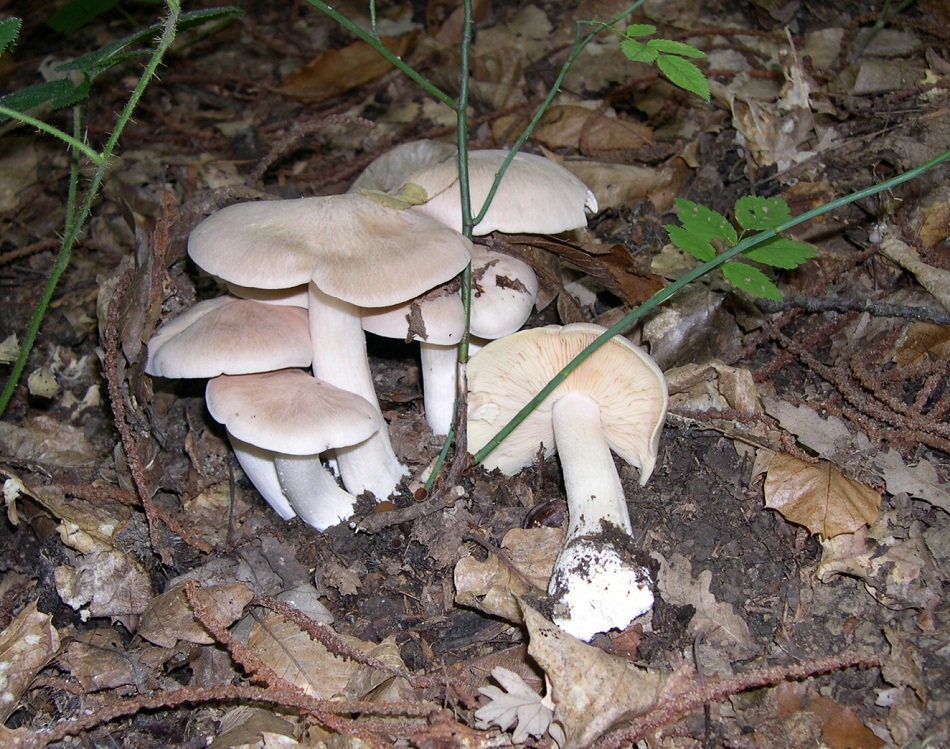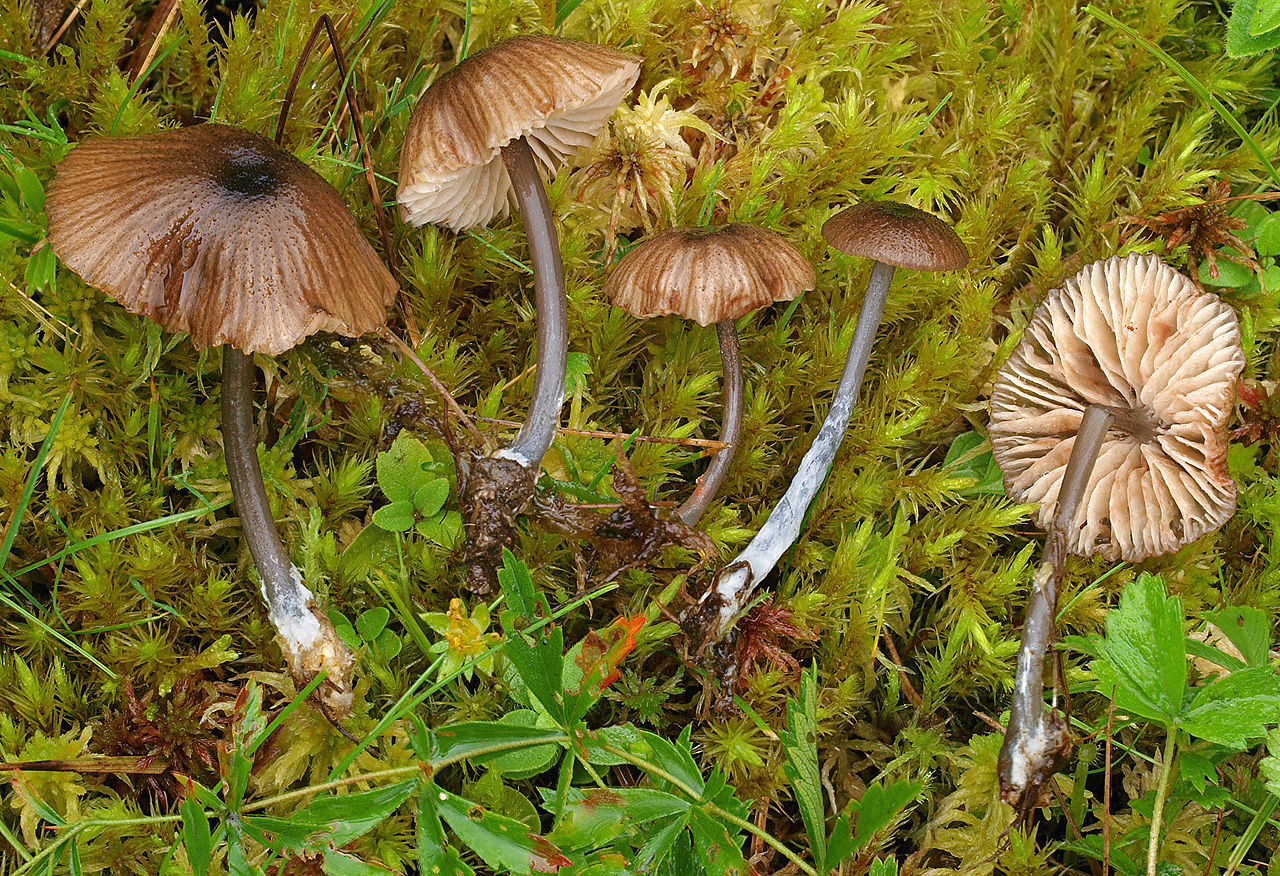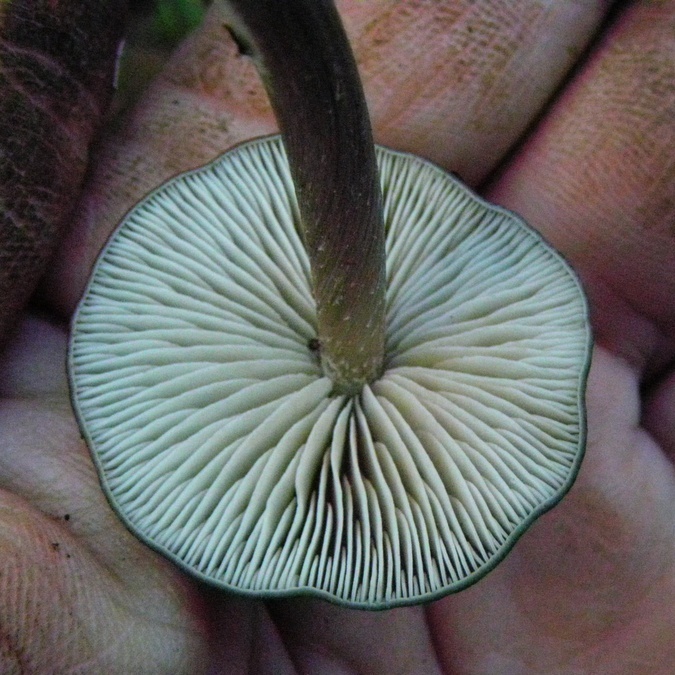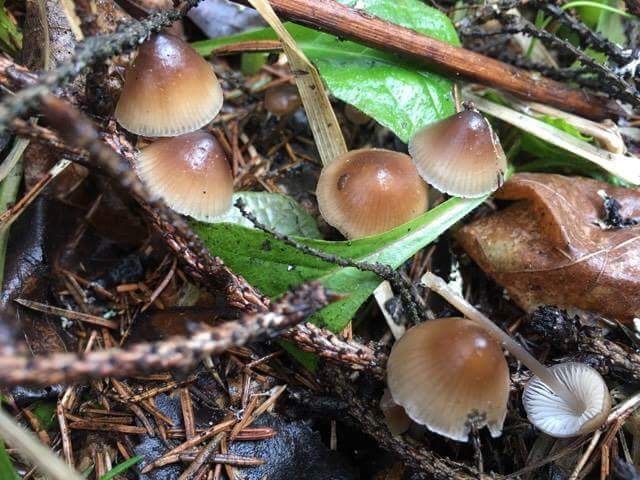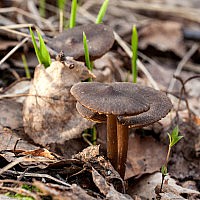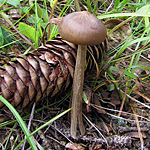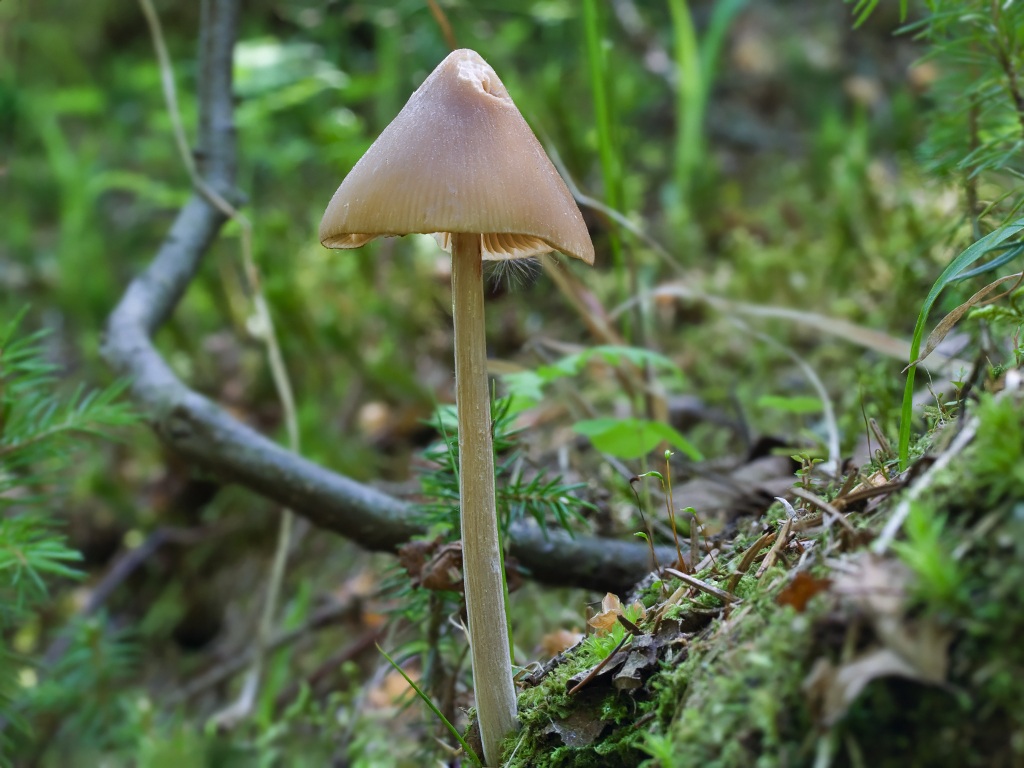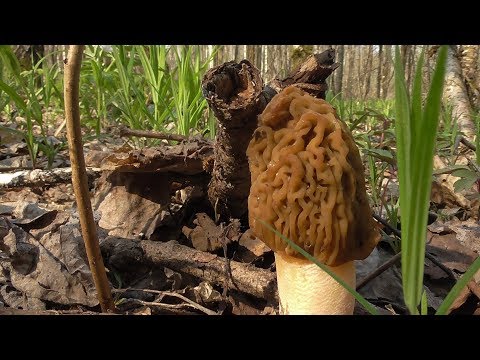Poisonous entoloma (rose leaf), its differences from other mushrooms
At the time of the mushroom "hunt" sometimes there are cases of poisoning with the gifts of the forest. The fact is that some poisonous mushrooms are very similar to edible ones. These include the poisonous entoloma - the largest representative of its family. Its fibers contain a strong poison that can be fatal without proper help.
The appearance of the mushroom
The poisonous lamellar mushroom entoloma, a description of which was first given by H. Person in 1801, is rather large. Usually the cap reaches a diameter of 6-16 cm, in rare cases - 25 cm.
At an early stage of development, the color of the cap ranges from off-white to gray with a touch of ocher. By old age, the color changes towards darker shades and becomes gray-brown. The cap is smooth to the touch; large specimens have small folds in its center.
When wet, the surface of the cap becomes sticky and shiny; when it dries, the shine remains.
In youth, the cap has a hemispherical shape, which, with age, becomes a bell with the edge wrapped around the leg. In old mushrooms, a notch appears on the cap in the center.
Red trellis mushroom: edible or not
The distinctive features of poisonous entoloma include the following:
- the flesh does not change color at the break;
- rare and wide plates;
- the smell of a young mushroom is mealy, with age it becomes rancid.
Distribution and places of growth
Poisonous entoloma, or poisonous rose leaf, is a relatively thermophilic mushroom. Distributed in the southern regions of Russia, comes across in the Caucasus, is well known to the inhabitants of Ukraine and the Republic of Belarus. This mushroom is rarely found in Karelia and the Murmansk region. In Western Europe, it practically does not occur - it is very rarely found in Austria and the mountainous regions of France.
He loves the neighborhood of hornbeam, beech, oak, sometimes it can be found near a willow or birch. Grows, as a rule, in small groups of 2-4 pieces. Favorite growing places are in the shade, under trees, in beams, on swampy soils with a high lime content.
Similar species
There are many edible mushrooms that are similar in appearance to the poisonous rose leaf, which poses a danger to novice mushroom pickers. Most often, fans of "mushroom hunting" confuse entoloma with the following mushrooms:
- pendant - the color is almost identical, the difference is in the plates descending to the leg;
- smoky ryadovka - differs in smaller plates, the color of which is noticeably lighter;
- pigeon ryadovka - differs in a hat, on which colored spots are noticeable, and flesh turning pink on the cut;
- smoky talker - it has a peculiar floral or putrid smell, the plates are narrower and lighter;
- common champignon - is distinguished by the presence of a ring on the leg and dark-colored plates;
- rose-leaf garden - an edible mushroom that grows in gardens and meadows, differs in that its cap has a hygrophilous property (swells when wet).
Edible and Poisonous Species of the Yellow Spiderweb Mushroom
Entoloma poisoning and treatment
When eating even a small piece of this poisonous mushroom, irritation of the gastrointestinal mucosa and intoxication of the body occurs with the following symptoms: severe migraine, vomiting, pain and cramps in the abdomen, diarrhea, dizziness. Signs of poisoning appear within 30-120 minutes.
Inpatient treatment usually lasts no more than 3-4 days. It is carried out permanently in the clinic with the intake of toxin-removing drugs. Glucose and saline are injected intravenously through a dropper.
First aid for poisoning before the arrival of an ambulance consists in washing the stomach, taking sorbents and laxatives.
If chills are observed, the victim should be wrapped in a blanket, blanket or additionally put on warm clothes.
Calling an ambulance is mandatory, you cannot try to cure the poisoning yourself. It is advisable to collect the remains of the mushrooms for transfer for examination to determine the type and degree of toxicity. In severe cases, a blood transfusion is required to save lives after entoloma poisoning, which can only be done in a clinical setting.
After providing first aid and carrying out the entire complex of medical procedures, a poisoned entoloma poisonous may for some time (1-2 weeks) experience deviations from the norm in the state of the body: frequent migraines, increased irritability, severe thirst and indigestion. In this case, it is recommended to take as much fluids as possible to remove toxins from the body.
Galerina edged mushroom: description and differences from honey agarics
Entoloma garden (Entoloma clypeatum)
Podzherdelnik
DESCRIPTION: The hat of an entoloma garden with a diameter of 7 to 10 (and even 12) cm. dry weather - silky fibrous, lighter. Its edge is uneven (wavy), sometimes with cracks.
The color of the cap varies from whitish-gray, beige and gray-brownish to grayish and gray-brown. The plates of the entoloma are wide, rather rare, adherent to the pedicle with a tooth, with a serrated edge, of unequal length.
In adolescence, entolomas are whitish, then they become pale pink, dirty pink or gray-brownish, and in old age they acquire a reddish tint. The pinkness of the plates is the main distinguishing feature of all enthol. A cylindrical, often curved, often twisted leg reaches a height of 10, sometimes 12 cm, in thickness - from 1 to 2 (and even 4) cm.It is brittle, longitudinally ribbed, solid, in old age, hollow, sometimes twisted, slightly under the cap furrowed.
The leg is whitish, pinkish or grayish in color. And its slightly thickened base is lighter. The ring on the leg is always missing. The pulp of entoloma is dense or soft, fibrous, white or brownish, with a weak mealy taste and smell, or even insipid.
Spore powder of pink color.
HABITAT AND GROWTH TIME: Entoloma orchard grows in deciduous and mixed forests under rowan, birch and oak trees - on nutrient-rich soil, along roads, in meadows, in gardens and on city lawns. In the garden, it often grows under fruit trees (apple and pear) and bushes of roses, rose hips, hawthorns and blackthorns.
It is widespread and common on the territory of the Leningrad region and in St. Petersburg, although it grows pointwise - from the last five days of May to the end of July with the most massive fruiting in June and in a wet, cool summer - and in July. Often it gives not one, but several short layers. Garden entoloma rarely appears alone, usually grows in groups, often in large.
TWINS: There is a very similar mushroom - the edible entoloma (Entoloma sepium) with a creamy, brownish-gray and even gray-brownish-greenish cap, notched-descending plates, white, shiny, long-fibered stem. Grows on lawns, gardens and bushes from late May to June.
The main task is not to confuse these two edible entolomes with Entoloma sinuatum or Poisonous Entoloma. The main differences of E. poisonous: a larger size (a cap up to 20 cm in diameter), a lighter (dirty whitish, creamy gray, grayish ocher and yellowish) cap with an easily removable skin, yellowish (in youth) plates, thicker ( up to 3 cm in diameter), a clavate leg, one-color with a cap, and a faint unpleasant smell of pulp. But this smell can be almost imperceptible. It is not found in the north of Russia.
There are two more relatively similar poisonous entolomes. Entoloma pushed through (Entoloma rhodopolium) with a thin yellow-cream, gray or brownish cap and ammonia odor. It grows from August to early October.And Entoloma spring - darker, shallow, slender and growing from the end of April to the last five days of May, that is, does not overlap with Entoloma Sadovaya in terms of timing.
EATABILITY: This is a conditionally edible mushroom. Boil entoloma for 20 minutes, and then put it in a roast, pickle or pickle. In southern Russia, dishes from it are from the category of traditional mushroom dishes, and in Western Europe, it is considered one of the best mushrooms.
Video about the mushroom Entoloma garden:
NOTES: The word "clypeatum" in the name of the mushroom means "shaped like a shield." Widespread on the globe: Western Europe, Ukraine, European Russia and North America. Appears in warm regions in April. The genus Entoloma has 153 species, among them there are edible mushrooms, but in order to use them for food, you need to be an experienced mushroom picker. The clearest photographs and the best descriptions cannot save you from error, so be careful with these mushrooms!
You don't have to go far for some types of mushrooms - they settle right on summer cottages and backyards. So, garden entoloma brings abundant mushroom harvests under fruit trees and shrubs.
Entoloma thyroid (Entoloma clypeatum)
- Other names for the mushroom:
- Entoloma garden
- Entoloma edible
- Thyroid rosacea
- Shield entoloma
- Thorny entoloma
- Entoloma forest
- Podlivnik
- Podrikosovik
- Podzherdelnik
OTHER NAMES:
DESCRIPTION:
The hat of an entoloma garden with a diameter of 7 to 10 (and even 12) cm.In youth it is bell-conical or convex, then unevenly spread and convex-concave, often with a tubercle, smooth, sticky in the rain, darker, in dry weather - silky fibrous, lighter. Its edge is uneven (wavy), sometimes with cracks.
The color of the cap varies from whitish-gray, beige and gray-brownish to grayish and gray-brown. The plates of the entoloma are wide, rather rare, adherent to the pedicle with a tooth, with a serrated edge, of unequal length.
In adolescence, entolomas are whitish, then they become pale pink, dirty pink or gray-brownish, and in old age they acquire a reddish tint. The pinkness of the plates is the main distinguishing feature of all enthol. A cylindrical, often curved, often twisted leg reaches a height of 10, sometimes 12 cm, in thickness - from 1 to 2 (and even 4) cm.It is brittle, longitudinally ribbed, solid, in old age, hollow, sometimes twisted, slightly under the cap furrowed.
The leg is whitish, pinkish or grayish in color. And its slightly thickened base is lighter. The ring on the leg is always missing. The pulp of entoloma is dense or soft, fibrous, white or brownish, with a weak mealy taste and smell, or even insipid.
Spore powder of pink color.

HABITAT AND GROWTH TIME:
Entoloma thyroid grows in deciduous and mixed forests under rowan, birch and oak trees - on nutrient-rich soil, along roads, in meadows, in gardens and on city lawns. In the garden, it often grows under fruit trees (apple and pear) and bushes of roses, rose hips, hawthorns and blackthorns.
It is widespread and common on the territory of the Leningrad region and in St. Petersburg, although it grows pointwise - from the last five days of May to the end of July with the most massive fruiting in June and in a wet, cool summer - and in July. Often it gives not one, but several short layers. Entoloma thyroid rarely appears alone, usually grows in groups, often in large.
TWINS:
There is a very similar mushroom - the edible entoloma pale brown (Entoloma sepium) with a creamy, brownish-gray and even gray-brownish-greenish cap, emarginate-descending plates, white, shiny, long-fibered stem. Grows on lawns, gardens and bushes from late May to June.
The main task is not to confuse these two edible entolomes with Entoloma sinuatum or Poisonous Entoloma. The main differences between E.poisonous: larger size (cap up to 20 cm in diameter), lighter (dirty whitish, creamy gray, grayish ocher and yellowish) cap with easily removable skin, yellowish (in youth) plates, thicker (up to 3 cm in diameter), club-shaped stem, one-color with a cap, as well as a faint unpleasant smell of pulp. But this smell can be almost imperceptible. It is not found in the north of Russia.
There are two more relatively similar poisonous entolomes. Entoloma pushed through (Entoloma rhodopolium) with a thin yellow-cream, gray or brownish cap and ammonia odor. It grows from August to early October. And Entoloma spring - darker, shallow, slender and growing from the end of April to the last five days of May, that is, does not overlap with Entoloma Sadovaya in terms of timing.
EDIBILITY:
This is a conditionally edible mushroom. Boil entoloma for 20 minutes, and then put it in a roast, pickle or pickle. In southern Russia, dishes from it are from the category of traditional mushroom dishes, and in Western Europe, it is considered one of the best mushrooms.
Video about the fungus Entoloma thyroid:
NOTES:
The word "clypeatum" in the name of the mushroom means "shaped like a shield." Widespread on the globe: Western Europe, Ukraine, European Russia and North America. Appears in warm regions in April. The genus Entoloma has 153 species, among them there are edible mushrooms, but in order to use them for food, you need to be an experienced mushroom picker. The clearest photographs and the best descriptions cannot save you from error, so be careful with these mushrooms!
Entoloma squeezed
Squeezed entoloma - lat. Entoloma rhodopolium
Otherwise, it is called Champignon squeezed, Entoloma pink-gray, Entoloma fuming, Champignon fuming, Rose-leafed autumn, Entoloma gray or Rose-leafed fuming.
Mushroom cap
The caps of the Autumn Pink Platter reach 25-120 mm in diameter. At first they are convex, later the hats spread out until they become squeezed - convex. The middle is crowned with a dark mound, after which a hole forms in it.
The smooth hat surface is characterized by a hygrophilous structure and changes color depending on the weather: on damp days it turns red or slightly brown, on dry days it becomes brownish gray or olive gray.
The edges of the hats are even and slightly tucked wavy; in old mushrooms they crack a little. They are somewhat translucent and have radial stripes.
The flesh of the pink-gray hat of Entoloma is usually tasteless, transparent white and fragile. It either does not smell or exudes a strong smell of alkali or nitric acid.
The bottom of the hats is filled with medium-frequency, wide, uneven plates that grow on the legs and subsequently with teeth descending along them. They are of different lengths. Young Entoloma has a sagging plate white or white - gray, sometimes with pink spots. In adult rosacea, the plates are deep pink, in old ones they are dirty yellow-pink.
Squeezed champignon reproduces by rounded - angular spores contained in a dirty pink spore powder.
Stipe
The fuming rose-leaf has a flattened cylindrical leg that grows up to 5-15 mm in thickness and 35-100 mm in height. It may thicken slightly downward or upward.
The surface of the legs is colored white, pale gray or light brown and remains smooth. A tiny whitish pile appears near the hat.
Legs of juveniles are filled with pulp from longitudinal fibers, adults are empty. The ring is not available.
Entoloma squeezed (Entoloma rhodopolium)
Growing places
Entoloma gray is found on damp grassy soils with fallen leaves of elms and birches; it rarely grows in conifers.
Fruiting occurs in groups - in the form of small or large groups, rings or rows and falls on the August-September days.
Edibility
Due to the high content of toxins, the Thinning Rose Platter belongs to inedible and even poisonous mushrooms.Eating it in food leads to severe food poisoning, in large quantities - to death.
Red Book
Are you here:
Home - the Red Book of the Rostov region. Plants - Entoloma gray-white KK Rostov region
Entoloma gray-white CC of the Rostov region
Department of Basidiomycetes - Basidiomycota Class Agaricomycetes - Agaricomycetes Order Agaricaceae - Agaricales Family Entolomaceae - Entolomataceae Entoloma lividoalbum (Kuehn. & Romagn.) Kubicka Rarity status category. 2 a. A species decreasing in numbers as a result of changes in conditions of existence or destruction of habitats. RRC - B.
Description
The cap is 3–6 (10) cm in diameter., Conical in youth, later convexly outstretched, occasionally gluey, with a curved edge (in young fruiting bodies), in the center, as a rule, with a dark obtuse tubercle. The color is zonal, yellowish-brown, when dry, the zoning is more pronounced, and the overall color tone is lighter. The plates are adherent, rather frequent, later free, darken with age to cream and deep pink. Spore powder, grayish-pinkish. The stem is central, cylindrical, sometimes slightly thickened at the base, long (5–10 x 0.5–1.5 cm), often cap color or lighter, with small light longitudinal fibrous scales. The flesh is whitish, darker under the skin of the cap, thick in the central part, increasingly thin on the periphery, often with translucent plates along the edges. The smell and taste are mealy. Spores are angular, 8–11 × 8–9 µm.
Spreading
In Europe, it is distributed in Estonia, Germany, and other countries; in Russia it is known only from the Rostov region. ... - In the Rostov region. occurs in the Azov (environs of the village of Kuleshovka), Ust-Donetsk (Nizhnekundryuchensky sandy massif, Ogib tract) districts and in Rostov-on-Don (Botanical Garden of the Southern Federal University; Chkalova settlement).
Features of biology and ecology
Mycorrhizal fungus. Grows in large groups in forests and plantations with a predominance of oak, in parks and gardens. Prefers humus-rich soils. Fruiting V – X.
Number
In some years favorable for climatic conditions, mass fruiting is noted. The population in the Azov region is not on the verge of extinction due to intensive industrial and agricultural development of the territory.
Limiting factors
High anthropogenic load on habitats (recreation, forest fires, grazing in forests, etc.). Mass collection of fruit bodies by the population.
Security measures
On adjacent to the Rostov region. territories have no legal status of protection. Protected at the Ogib Tract in the Ust-Donetsk region and the Southern Federal University Botanical Garden in Rostov-on-Don. It is necessary to search for new locations of the species in the area. This mushroom should be promoted among the local population as rare and in need of protection. Artificial cultivation of the mushroom in protected areas is possible. It is advisable to separate it into a pure culture and preserve it as a part of mushroom collections of living cultures.
Practical value. Edible mushroom with low gustatory characteristics (according to some authors, inedible).
Sources of information. 1. Urbonas, Kalamees, Lukin, 1986; 2. Bon, 1987; 3. Chipped, 1990; 4. Vychepan, Rusanov, 1996.
Compiled by. Rusanov V.A.
Photo. Morozova O.V.
|
15.12.2017 20:40:23
-
Menu
- home
- Photo gallery
-
Animals
- Mammals
- Birds
- Fishes
- Amphibians
- Reptiles
- Insects
- Crustaceans
- Worms
- Molluscs
-
Plants
- Angiosperms
- Gymnosperms
- Ferns
- Mosses
- Seaweed
- Lichens
- Mushrooms
- Moscow
-
Moscow region
- Mammals
- Birds
- Invertebrates
- Pisces, presm., Terrestrial.
- Plants
- Mushrooms, mosses, lichens
-
Voronezh region
- Plants
- Animals
-
Republic of Crimea
- Plants
- Animals
-
Rostov region
- Plants
- Animals
-
Krasnodar Territory
- Plants
- Animals
-
Leningrad region
- Plants
- Animals
-
Pskov region
- Plants
- Animals
-
Sverdlovsk region
- Plants
- Animals
-
Saratov region
- Mushrooms
- Bryophytes
- Ferns
- Amur region
- Krasnoyarsk Territory
- Belgorod region
-
Chelyabinsk region
- Plants
- Animals
-
IUCN Red List
- Extinct mammals
- Rare birds of the world
- Cetaceans
- Carnivores
- Reserves of Russia
- Wild animals
- Birds of Russia
- Download the Red Book
- Basic documents
- Custom sog.
- .
Definitioner
- Basidia (Basidia)
-
Lat. Basidia. A specialized structure of sexual reproduction in fungi, inherent only in Basidiomycetes. Basidia are terminal (end) elements of hyphae of various shapes and sizes, on which spores develop exogenously (outside).
Basidia are diverse in structure and method of attachment to hyphae.
According to the position relative to the axis of the hypha, to which they are attached, three types of basidia are distinguished:
Apical basidia are formed from the terminal cell of the hypha and are located parallel to its axis.
Pleurobasidia are formed from lateral processes and are located perpendicular to the axis of the hypha, which continues to grow and can form new processes with basidia.
Subasidia are formed from a lateral process, turned perpendicular to the axis of the hypha, which, after the formation of one basidium, stops its growth.
Based on morphology:
Holobasidia - unicellular basidia, not divided by septa (see Fig. A, D.).
Phragmobasidia are divided by transverse or vertical septa, usually into four cells (see Fig. B, C).
By type of development:
Heterobasidia consists of two parts - hypobasidia and epibasidia developing from it, with or without partitions (see Fig. C, B) (see Fig. D).
Homobasidia is not divided into hypo- and epibasidia and in all cases is considered holobasidia (Fig. A).
Basidia is the place of karyogamy, meiosis and the formation of basidiospores. Homobasidia, as a rule, is not functionally divided, and meiosis follows karyogamy in it. However, basidia can be divided into probasidia - the site of karyogamy and metabasidia - the site of meiosis. Probasidium is often a dormant spore, for example in rust fungi. In such cases, probazidia grows with metabasidia, in which meiosis occurs and on which basidiospores are formed (see Fig. E).
See Karyogamy, Meiosis, Gifa.
- Pileipellis
-
Lat. Pileipellis, skin - differentiated surface layer of the cap of agaricoid basidiomycetes. The structure of the skin in most cases differs from the inner flesh of the cap and may have a different structure. The structural features of pileipellis are often used as diagnostic features in descriptions of fungi species.
According to their structure, they are divided into four main types: cutis, trichoderma, hymeniderma and epithelium.
See Agaricoid fungi, Basidiomycete, Cutis, Trichoderma, Gimeniderm, Epithelium.
- Cutis
-
The type of cap skin, consists of creeping non-gelatinized hyphae located parallel to the surface. The surface of the cap looks smooth.
Lat. Cutis.
See Gifa.



